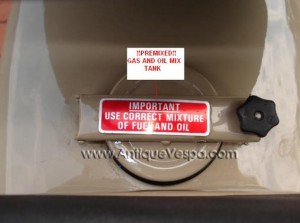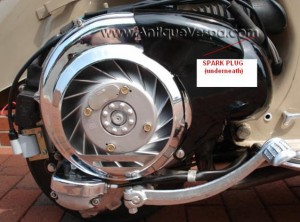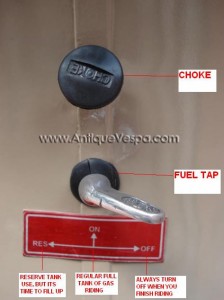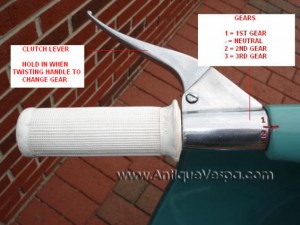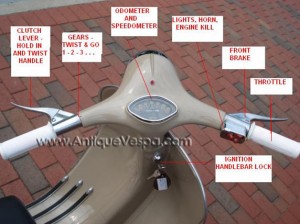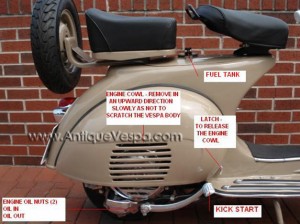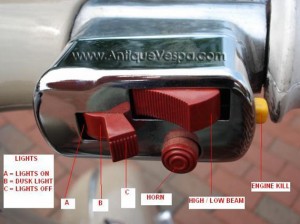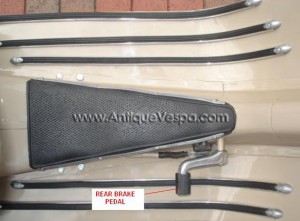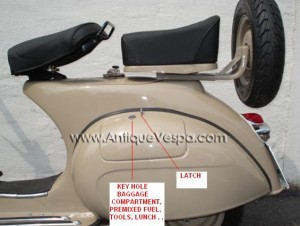|
The Vespa Guide http://vespaguide.com/?p=966 Export date: Sun Jun 1 22:24:24 2025 / +0000 GMT |
Running A Vespa Engine Rebuild For the First Time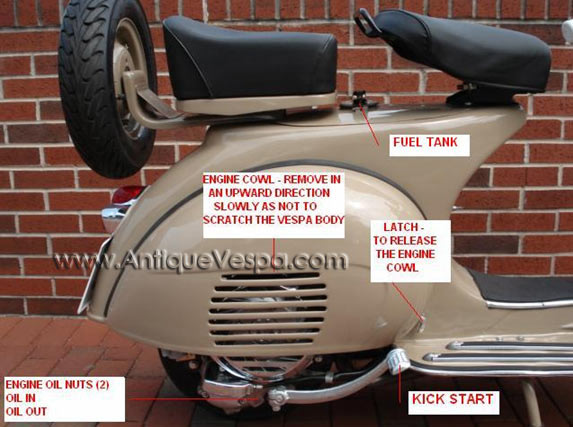 Courtesy AntiqueVespa.com OPERATING & MAINTENANCE Before cruising your new scooter, please get yourself familiar with the following features; it is also extremely important to remember the following rules:- Break In Your Engine for maximum performance, reliability and longevity! No matter how well and careful an engine is rebuilt, it must have a break-in period, so be gentle for first 100 miles or so - Break-in is necessary! 2. Your Vespa has remained motionless for a while, so it is advisable to perform the following task before starting the engine – Remove right cowl where the engine is located, remove the spark plug, pour 50ML of two stroke synthetic oil into the spark plug hole (Use a long funnel applicator) Tighten the spark plug back into it's socket, place the gold clips back around the top of the spark plug, and put the cowl back over the engine. (This will lubricate the pistons and bearings for a better and smoother performance) 3. Make sure your Fuel Tap switch is in the "On" position, the Tap points up to the sky. When you have to use Reserve gas (R), it's advisable to begin looking for a Gas station and fill up with Gas. 4. Pull out the choke tap which is located above the fuel tap; kick start a few times until it starts (Be patient, your vespa has been sitting in transit for a while). When it's running, push the choke in before cruising. Always warm up the engine before riding at full speed. 5. Always make sure the gear is in ‘Neutral' position before starting the engine (move gears dot-to-dot, not dot to number). Squeeze the clutch lever before shifting gears, just like operating a manual transmission in your car. Square button is ‘Engine Kill' switch, this will stop engine completely. Baggage / Glove Box - It's useful to keep various tools in here. BREAKING IN THE ENGINE Operation: The most important period in the life of your scooter is the first 1250 miles. The engine may be brand new and different moving parts of the engine need to be set to their correct operating tolerances. This ensures a longer life for your scooter, therefore it is necessary to take some precautions so as not to overload the engine. Keep to the following speed limits 1st Gear : 0 to 6 miles/hr 2nd Gear : 6 to 12.5 miles/hr 3rd Gear : 12.5 to 22 miles/hr 4th Gear : 22 miles/hr and above Vary the speed from time to time.
Every location is going to have different tuning characteristics altitude and temperature have major impacts on engine jetting The hotter it is the less fuel you need - jet # The cooler it is the more fuel you need + jet # The higher altitude you go less fuel -jet # The lower SEA LEVEL more fuel +jet# This engine comes with a 94 main jet This works for an average 80o at 5000ft You want a spark plug with an electrode color of light brown, this shows proper mixture for your area / altitude: Black Spark Plug: Too rich, White: too lean, Tan: just right! This is for the main jet setting only. The idle mixture is on the rear of the carburetor, this adjusts the mixture at idle and 1/8 throttle opening. Most bikes will be within 1.5 to 3 turns out, set this after the bike warms up by adjusting it in and out to find the highest idle rpm. Then set idle speed with the air speed screw on the top of the carburetor to 950 to 1200 rpm. |
|
Post date: 2016-03-20 23:06:22 Post date GMT: 2016-03-20 23:06:22 Post modified date: 2016-03-20 23:06:22 Post modified date GMT: 2016-03-20 23:06:22 |
|
Export date: Sun Jun 1 22:24:24 2025 / +0000 GMT This page was exported from The Vespa Guide [ http://vespaguide.com ] Export of Post and Page has been powered by [ Universal Post Manager ] plugin from www.ProfProjects.com |
